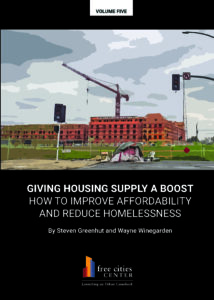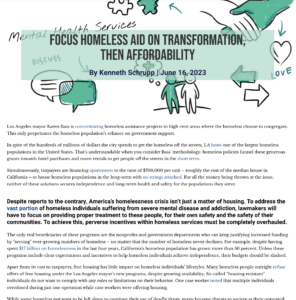It’s build or bust in California,
as subsidies can’t cut it
by Kenneth Schrupp | April 19, 2024
With a 4.5-million home shortage driving California to have the 49th-worst ratio of residences to residents in the nation, efforts to increase up-front affordability without increasing the abundance of homes is resulting in a continued housing shortage.
As cities and states consider new means of appeasing cash-strapped voters – left struggling to secure housing by limited housing production driven by government restrictions and disincentives – it is vital to limit new increases in housing subsidies that benefit a lucky few but leave everyone else paying more. Moreover, the only policy option left for a deficit-plagued California is to allow the construction of more homes, a move that could be done with the brush of a pen and not billions of dollars in subsidies and red tape.
California is now considering expanding the state’s zero-down, no-payment home “loan” program to illegal immigrants under the California Dream for All Shared Appreciation Loans program. It allows first-time home buyers to get a loan from the state for up to 20% of the purchase price of a home or apartment, with zero interest and zero monthly payments.
The state is supposed to make its money back when the borrower sells or refinances the house by requiring the borrower to then pay back the original loan amount plus 20% of the increase in the home’s value, should an increase have occurred. Assembly Bill 1840 aims to clarify that CDASAL is available to illegal immigrants, a proposal that drew immediate ire from state leaders.
“Assembly Bill 1840 is an insult to California citizens who are being left behind and priced out of homeownership,” said state Sen. Brian Dahle, R-Bieber, in a statement. “I’m all for helping first-time homebuyers, but give priority to those who are here in our state legally.”
But rather than simply decry the state for providing unfair access to a taxpayer-funded program to illegal immigrants, it would be prudent to re-examine the state’s priority of subsidizing demand amid an ongoing $73 billion budget deficit and a housing-price-driven exodus out of the state.
The program started in 2023 with $300 million set aside for 2,300 applicants. It ran out of funds in just 11 days, leading to this year’s changes to program rules that require applicants to be first-generation home buyers and reduce maximum income thresholds to 120% of county median household income, and for applicants to enter a lottery for the chance to file an application.
Hosting a lottery to be able to afford a home down payment isn’t a fair government policy, especially when government policy is responsible for the housing shortage that’s driving Californians into poverty in the first place.
Indeed, AB 1840 comes as most of the increase in California housing production in the last decade can be attributed to the allowing of accessory dwelling units, according to a new analysis from California YIMBY. While the permitting of nearly 84,000 ADUs between 2016 and 2022 in California is commendable (and accounts for 19% of new units in 2022), this increase is hardly making a dent in the state’s housing shortage.
In 2022, California built just 116,000 units of housing. At that rate, it would take 34 years for the state to meet current demand, taking the average of a 2022 paper from University of Chicago and George Mason University researchers finding a 4.5 million unit housing shortage and California YIMBY’s 3.5-million shortage estimate.
The state, which faces a $73 billion deficit for the 2024-2025 fiscal year, simply doesn’t have the money to subsidize the purchase of the state’s 71,000 homes for sale. Assuming the average home price of $750,000, a 20% down-payment program – absent price increases resulting from immediate broadening of those who can afford to secure a mortgage – a down-payment program covering every California home for sale would cost nearly $11 billion.
Given this fiscal reality, it is impossible for the state to subsidize its way out of its housing shortage, especially when one considers that subsidies will only increase the number of potential homebuyers in a given environment, thus driving up housing prices even further. Subsidy-type housing policies are correlated with increases in housing costs, a result that should be intuitive for anyone with a grasp on basic economics.
When the George W. Bush administration spent $200 million per year expanding home-buying subsidies, the proliferation of easy credit and resulting housing bubble and crash left “homeownership rates are virtually no higher” than at the start of the administration, an economy in tatters, home prices out of control, and banks forced to be bailed out with billions of dollars in taxpayer money, according to The New York Times.
When there was widespread mortgage forbearance – reductions and pauses on mortgage payments – during the COVID-19 pandemic, the Federal Reserve determined there was a “strong positive relationship between forbearance take-up and house price growth at the county level, controlling for the unemployment rate and other factors.” It found that “forbearance supports house prices partly through restricting new listings by borrowers experiencing negative labor market shocks,” wrote the Federal Reserve’s researchers.
No one ought to have been forced out of one’s home due to loss of work from government-mandated lockdowns, but the resulting impact was home prices increased 29% from the onset of the pandemic while home ownership decreased. Now, 45% of Californians are considering leaving the state due to the high cost of housing. With so many residents leaving, S&P says “absent the state’s ability to adapt by cutting expenditures,” declining revenues from immigration could “lead to credit quality deterioration.”
With one in four Californians expected to be 60 or older by 2030, how are a declining number of workers supposed to pay for state benefits for a growing population of retirees?
The state can’t possibly afford the subsidies it wishes to spend to keep Californians in their homes, or get them into new homes. The only option left – and a move that can be done without costing taxpayers an extra dime – is legalizing housing production to the extent that housing is once again affordable at market rates to any working family. For California, it’s build or bust.
Kenneth Schrupp is the California reporter for The Center Square. His commentary and analysis have been published by Newsweek and RealClearPolitics.



